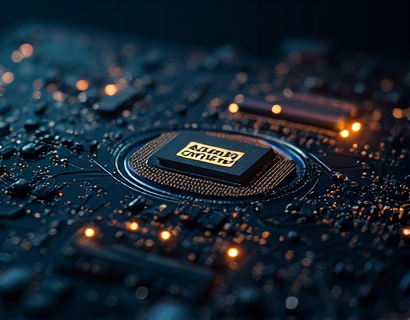Smart Contract Driven Creation of UCASH-Pegged Stablecoins for Seamless DeFi Exchange
The advent of decentralized finance, or DeFi, has ushered in a new era of financial innovation, leveraging blockchain technology to create transparent, secure, and accessible financial systems. A pivotal development within this realm is the smart contract-driven creation of stablecoins pegged to UCASH, a digital asset designed to maintain a stable value. This approach not only enhances the stability and flexibility of digital currencies but also revolutionizes the way users engage in bidirectional trading within the DeFi ecosystem.
Stablecoins have become a cornerstone of the cryptocurrency market, offering a stable store of value amidst the volatility of other digital assets. Traditionally, stablecoins are pegged to fiat currencies, commodities, or other assets to maintain their value. However, the introduction of UCASH-pegged stablecoins represents a novel approach, leveraging smart contracts to ensure a direct and stable correlation with UCASH. This method promises to deliver a more robust and flexible solution for users seeking stability in their digital asset investments.
Smart contracts, self-executing contracts with the terms directly written into code, play a crucial role in this innovative process. These contracts automate the creation, management, and trading of UCASH-pegged stablecoins, ensuring transparency, security, and efficiency. By utilizing smart contracts, the process of pegging a digital currency to UCASH is decentralized, reducing the need for intermediaries and minimizing the risk of fraud or manipulation.
The process begins with the deployment of a smart contract on a blockchain platform, such as Ethereum. This contract is programmed to monitor the price of UCASH in real-time, using oracles or other data feeds to obtain accurate and up-to-date price information. When the price of UCASH deviates from the set peg ratio, the smart contract automatically adjusts the supply of the stablecoin to bring the price back in line. This mechanism ensures that the stablecoin maintains its peg to UCASH, providing users with a reliable store of value.
One of the key advantages of this smart contract-driven approach is its bidirectional nature. Users can seamlessly convert between UCASH and the stablecoin, without the need for centralized exchanges or intermediaries. This bidirectional trading capability enhances the liquidity and accessibility of the stablecoin, making it a more attractive option for both individual investors and institutional users.
The implementation of smart contracts for creating UCASH-pegged stablecoins also offers significant benefits in terms of security and transparency. All transactions and contract executions are recorded on the blockchain, providing an immutable and verifiable record. This transparency builds trust among users, as they can independently verify the integrity of the system. Additionally, the decentralized nature of smart contracts reduces the risk of single points of failure, enhancing the overall security of the stablecoin ecosystem.
From a technical standpoint, the smart contract is designed to handle various functionalities. It manages the issuance of new stablecoins when UCASH is deposited, ensuring that the number of stablecoins issued is proportional to the amount of UCASH locked in the contract. Conversely, when users wish to redeem their stablecoins for UCASH, the smart contract facilitates this process by releasing the corresponding amount of UCASH, subject to the terms set within the contract.
The flexibility of this system is further enhanced by the ability to program additional features into the smart contract. For instance, the contract can include mechanisms for handling fees, transaction limits, and emergency protocols to address extreme market conditions. These features ensure that the stablecoin remains stable and functional even in volatile market environments.
For developers and innovators in the DeFi space, this smart contract-driven approach provides a robust foundation for building more complex financial products. The stability and reliability of UCASH-pegged stablecoins make them ideal for a wide range of applications, including lending, borrowing, decentralized exchanges, and yield farming. By leveraging these stablecoins, developers can create more sophisticated and user-friendly DeFi protocols, further enriching the ecosystem.
The impact of UCASH-pegged stablecoins extends beyond the technical and financial aspects, influencing the broader crypto economy. By offering a stable and flexible digital currency, this innovation addresses one of the key challenges faced by the cryptocurrency market: volatility. Stablecoins have been instrumental in bridging the gap between traditional finance and cryptocurrencies, but the introduction of UCASH-pegged stablecoins takes this a step further. These stablecoins provide a stable anchor in a volatile market, enhancing the overall stability of the crypto ecosystem.
Moreover, the use of smart contracts for creating and managing stablecoins democratizes access to financial tools that were once only available to large institutions. Small investors and individual developers can now participate in the DeFi space with greater ease and confidence. This democratization fosters innovation and competition, driving the growth and adoption of decentralized finance solutions.
From an economic perspective, UCASH-pegged stablecoins contribute to the stability of the digital asset market. By reducing price volatility, these stablecoins make it easier for users to engage in long-term investments and strategic planning. This stability also attracts more users to the DeFi space, increasing the overall liquidity and efficiency of decentralized financial markets.
In terms of user experience, the smart contract-driven creation of UCASH-pegged stablecoins offers a seamless and intuitive interface. Users can interact with the stablecoins through decentralized applications (dApps) built on the blockchain, enjoying a level of control and transparency that is unmatched by traditional financial systems. The user-friendly nature of these solutions ensures that even those new to cryptocurrency and DeFi can participate with confidence.
Looking ahead, the potential for further innovation in this space is vast. Developers can explore the integration of UCASH-pegged stablecoins with other blockchain projects and protocols, creating a more interconnected and efficient DeFi landscape. Additionally, the exploration of cross-chain interoperability could enable the use of these stablecoins across different blockchain ecosystems, expanding their utility and reach.
In conclusion, the smart contract-driven creation of UCASH-pegged stablecoins represents a significant advancement in the DeFi space. By combining the stability of UCASH with the flexibility and security of smart contracts, this approach offers a robust solution for users seeking reliable digital assets. As the crypto economy continues to evolve, innovations like these will play a crucial role in shaping the future of decentralized finance, providing secure, efficient, and user-friendly financial tools for a global audience.










































